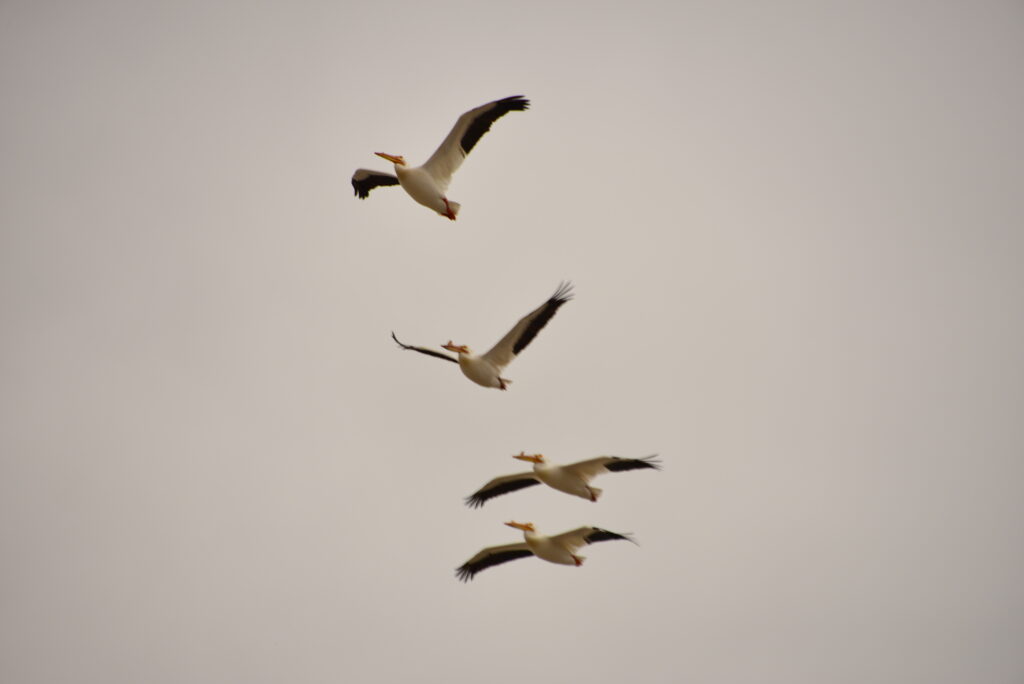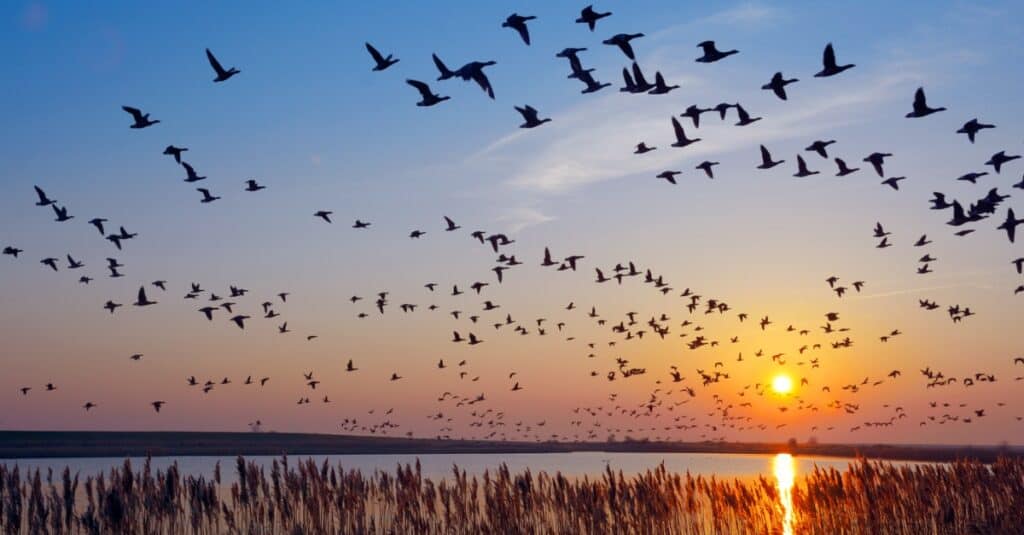Bird migration is such a complex phenomenon that we can only cover about 1% of it in this article. There are hundreds of studies, numerous research papers, and books on it, indicating there’s so much to know about it that it would take us months to get to the bottom of how, why, and where birds fly!
However, we’ve gone the extra mile just for you and selected some key facts about bird migration. While it would be impossible to share with you extended explanations of why birds fly, we’ve made an elaborate presentation that would help you get a broad perspective on this behavior.
What Is Bird Migration?

Bird migration represents the bird’s seasonal moving along a flyway.
©iStock.com/Elizabeth Lara
Bird migration stands for the bird’s seasonal moving along a flyway. While people often think birds migrate before winter because the temperatures drop, this isn’t the primary reason.
While low temperatures cause birds to leave their houses, they would rather do so because food becomes scarce during winter.
Nevertheless, this isn’t the only reason birds migrate. After all, migration has been part of birds’ genetics for thousands of years! Bird migrations have been recorded for more than 3,000 years now. Aristotle’s first written recording about bird migration was done some 2,000 years ago!
However, research shows that only in the 1700s and 1800s scientists started to investigate bird migration thoroughly, and not even today have they discovered everything there is to know about this behavior.
How, Why, and Where Do Birds Migrate?

Experts believe that the main cause of migration is the change in food availability.
©eurotravel/Shutterstock.com
Some birds travel due to habitat and weather changes and if the food becomes scarce. However, not all bird travels are labeled as migrations. While some species may often move from place to place, migrations occur seasonally.
Experts believe that the main migration cause is the change in food availability. The explanation is that some migratory birds choose not to leave their homes if fed through the winter. Moreover, not all populations in a species are migratory. This is called “partial migration” and is common in southern regions.
Most birds migrate along a flyway towards the north in the spring. This migration happens for feeding and breeding purposes. They breed in temperate regions or the Arctic. When fall comes, they return to the south.
Many species migrate in V-like flocks, thus conserving around 20% of the energy they would have used if they had flown alone. They fly at various altitudes, depending on their location. Some were spotted flying 16,000 feet high, while others were more than 21,000 feet above the ground.
Some birds prefer flying at night, thus exhibiting the so-called nocturnal migratory behavior. They fly the whole night, then land in the morning and rest and feed for a few days. Moreover, they give short, contact-type nocturnal flight calls, which aim to maintain the flock composition, avoid collision, or even indicate the sex of the migrating birds.
The long-distance migration routes are established genetically and traditionally and depend on the species’ social systems. Some birds, Ciconia ciconia or white storks, for instance, are led by the oldest birds. Besides, not all birds follow the direct line between wintering and breeding grounds. They follow a route that includes suitable stopover habitats where they can rest and feed. On the other hand, some birds fly non-stop for more than 4,000 miles.
Besides long-distance migration, some birds perform short-distance or altitudinal migration. Some species, including wallcreepers and white-throated dippers, usually migrate altitudinally to avoid the cold higher ground. Other birds move to the coast or the south. Several species, though, rarely move further than three miles from their natural habitats.
Migration Risks for Birds
Migration can cause high-stress levels and physical exhaustion. Moreover, during migration, birds are at a higher risk of predation. Besides this, since they fly in high concentrations, they’re likely to become infected with parasites and pathogens and transmit them to their populations. Therefore, sometimes birds choose not to migrate if they have food throughout winter.
Moreover, since thousands of airplanes travel the skies, migrating birds are at a high risk of being hit by airplanes. More and more bird strike accidents are reported nowadays, and most happen at around 2,000 feet above the ground.
Nocturnal migration may be a solution for minimizing the negative impact migration has on birds. During the night, predation risks are lower, birds do not overheat, and they can spend their days feeding and resting.
Where Do Birds Spend the Winter Specifically?
Birds that prefer short-distance migration will travel to the Southern United States in regions like California, Texas, Arkansas, Louisiana, North Carolina, and South Carolina. Others, however, travel much beyond the United States, as far as southern Mexico’s tropical climates and Central America. Other species, like the indigo bunting or the American redstart, go to the Caribbean. Many birds are strong enough to fly as far as Ecuador.
If you’re wondering what routes birds take during migration, we have some examples in mind:
- Western tanagers may travel from Oregon to Costa Rica
- Wood thrushes may travel from Ontario to Mexico
- Blackpoll warblers may travel from Eastern Canada to Northern South America
- Scarlet tanagers may travel from Pennsylvania to Brazil.
Can You Track Migrating Birds?
If you’re a bird enthusiast, you’re probably wondering where you can spot birds migrating this year. We have good news! There’s a US live bird migration map based on the US weather surveillance radar network. The latest update showed that the highest migration traffic rate was registered in the Southeastern United States, and all birds were flying south; some were flying to the southwest. However, this map registers only nocturnal bird migrations.
On the other hand, if you want to dive deep into bird migration, you should check the Audubon Bird Migration Explorer, where you can look for specific species, most of which are tracked with high precision. For example, the American Bittern spends its winter in southern Texas and Louisiana, then moves to the north at the end of March – the beginning of April, then flies back south in October.
What Other Animals Migrate?

Emus migrate by foot during droughts.
©iStock.com/Gilnature
Did you know that birds aren’t the only ones to migrate? Penguins migrate by swimming! They can swim more than 600 miles!
Dusky grouses are known to engage in walking altitudinal migration, while emus migrate by foot during droughts.
Up Next:
- 8 Birds That Migrate The Longest
- New Study: Migratory Birds “Surf” Winds Over Sea
- The Top 10 Highest Flying Birds in the World
- Discover 10 Birds That Fly South For The Winter (And 5 That Don’t)
The photo featured at the top of this post is © Images by Dr. Alan Lipkin/Shutterstock.com
Sources
- Birds and Blooms, Available here: https://www.birdsandblooms.com/travel/birding-hotspots/where-do-migrating-birds-spend-the-winter/
- BirdCast, Available here: https://birdcast.info/migration-tools/live-migration-maps/
- Colossal, Available here: https://www.thisiscolossal.com/2022/10/bird-migration-explorer-audubon/
- Audubon, Available here: https://explorer.audubon.org/explore/species/1394/american-bittern/migration?sidebar=collapse&zoom=4&x=99977.27668362868&y=1553509.0008083875&hide=migration-journey-graphics&range=0.5575%2C0.5775
Thank you for reading! Have some feedback for us? Contact the AZ Animals editorial team.






